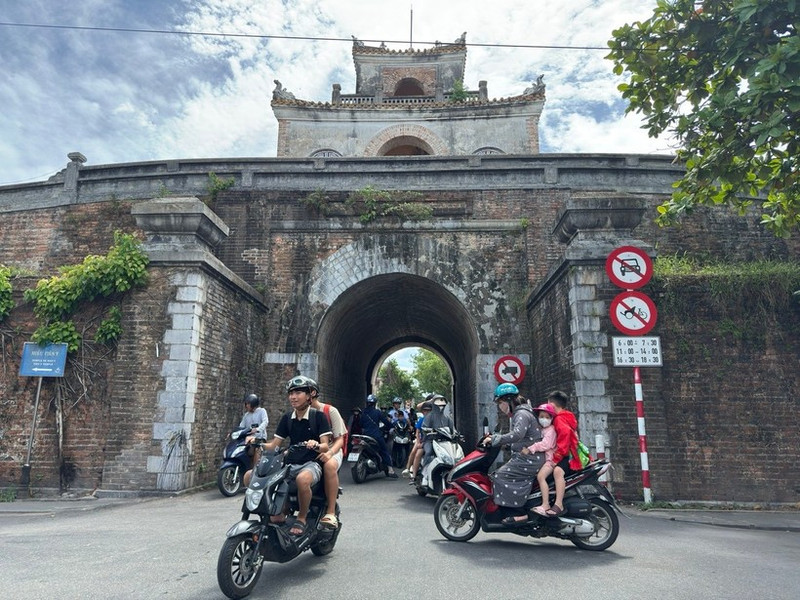Cultural tourism potential of Hue’s core area
Phu Xuan Ward has just been established through the merger of six inner-city and outer-city wards of Hue, encompassing the Imperial City, Forbidden City, and the ancient quarters of Dong Ba and Gia Hoi. This is an area rich in potential for cultural tourism development.

Golden memories
Located in the heart of the city, the Hue Imperial City, once the centre of Nguyen Dynasty power, still retains its solemn and majestic appearance. Surrounded by moats, walls and traditional architecture, this place bears the profound imprint of Viet Nam’s last imperial dynasty.
Outside the city gates, across the Dong Ba River, lies the ancient quarter of Gia Hoi. This neighbourhood was formed during the time of the Nguyen Lords and became a bustling commercial centre in the early 19th century, a trading hub for Chinese, Indian and Spanish merchants.
They not only brought goods but also left cultural marks on many architectural structures throughout the quarter. The ancient quarter was also home to the mansions of princes and mandarins of the Nguyen Dynasty, interspersed with traditional houses known as “ruong”.
This was also home to a community of residents, primarily people native to Hue, with many traditional crafts. Ancient stately Buddhist temples are also found in the area.
One could say that Gia Hoi is a miniature Hue, blending court, folk and religious cultures. Today’s Gia Hoi can still be regarded as a museum of Hue’s urban memory.
The Imperial City remains an important destination whenever tourists visit Hue. However, most tourists only take a brief tour before leaving, with few staying to explore the Imperial City’s space in depth.
Besides the limitations in services and many ruins still awaiting restoration, transport within the Imperial City is not yet efficient, while there is a lack of clear interaction between heritage spaces and urban life.
Phu Xuan Ward, recently formed from the merger of old wards, encompasses this entire area. However, the management and organisation of living spaces and heritage spaces here has remained fragmented for many years. The gap between monuments and residential communities has not been bridged.
Therefore, the Ngu Ha River cleaning campaign just before the nationwide transition to the two-tier local government model was a positive move. The “royal river” flowing through the Imperial City, which had been silted and polluted for many years, has now been dredged and cleaned, bringing a new appearance to the inner city area.

Removing transport bottlenecks
On a small boat from Dong Ba River into Ngu Ha, a tourist from Ha Noi said: “Entering the Imperial City by river feels much more relaxed than going by motorbike or car.”
Despite covering over 500 hectares, the Imperial City has only 10 gates, each less than 4 metres wide. Bridges such as Khanh Ninh and Vinh Loi were all built in the 19th century and currently only accommodate motorbikes and small cars, causing growing pressure on the heritage space. Residents’ movement is constantly hampered by inadequate traffic management.
Architect Truong Hong Truong, a lecturer at the Faculty of Architecture at Hue University of Sciences, stated that: “Rather than trying to open new roads or demolish gates, we should reorganise traffic flow. We could divide the area into one-way traffic routes, combined with light transport such as electric vehicles and bicycles.”
He gestured towards the river: “If we reconstruct a few small bridges across Ngu Ha, then people could walk or cycle to the other bank, creating additional connections while preserving the ancient spatial structure.”
This suggestion has gained support from many residents within the Imperial City. Tuyet Loan, a primary school teacher, said: “If parking is prohibited on the main routes and pavements are clear, walking would be more comfortable. Motorbikes could be parked on pavements along one-way side streets, with small car parks planned in the Thanh Loi area and unused plots of land, ensuring convenience for everyone.”
Phuong Mai, who runs accommodation services on Phung Hung Street, shared: “When the space is clean and quiet, service providers must also be more meticulous. Visitors will have time to appreciate, rather than sleep ing across the Perfume River, buying tickets to see the Imperial City, then returning.”
A well-organised living space would create better conditions for both residents and tourists. If properly organised, this area would be easier to live in, navigate, and develop services.
Beginning of the dream of living heritage
After the merger, Phu Xuan Ward has become a vital area of the city. This is a world heritage site and home to thousands of households who have been connected to the Imperial City for many years.
Nguyen Xuan Hoa, former director of the former Thua Thien Hue Province’s Department of Culture and Information, who currently runs a highly successful Hue-style restaurant in the Imperial City, said: “For the Imperial City to become living heritage, there must be community participation. If properly organised, I believe every house and every street could contribute to telling Hue’s stories.”

To retain tourists, there must be suitable accommodation that embodies Hue’s characteristics. Hoa still cherishes the idea that one day, inside the Imperial City, there will be traditional “ruong” houses serving guests, or low-rise boutique hotels in local architectural style. It may even be time to consider land use planning to develop high-end resort services.
Le Dac Nguyen Quy, formerly owner of a large bar on Vo Thi Sau Street, wondered: If there were policies encouraging investment in accommodation points along streets in Gia Hoi, combined with old-style eateries, tea shops, bookshops... could this create a service chain with a strong cultural identity?
Within the Imperial City, along the Ngu Ha riverbank, small markets could be organised where residents sell traditional Hue dishes. There tourists could sit by bridges, enjoy food and drinks, and experience the friendliness of Hue people.
During its over 150 years of existence, Hue Imperial Capital was a place that attracted many skilled artisans from craft villages across the country. Although the city no longer holds that status, many of their descendants remain. If encouraged to organise craft streets and handicraft villages for tourists to experience and shop, would they be willing?
Phu Xuan Ward also needs to coordinate with schools, institutes, and cultural enterprises to organise art streets and short-term classes such as enamel painting, incense making, ao dai tailoring.

In Hoi An Ancient Town, following liberation, only a few ancient houses remained on some main streets, but recently Hoi An became Viet Nam’s sole representative on the list of the world’s ten best cities for 2025 as voted by TravelLeisure magazine.
What makes it special is that when residents themselves share heritage stories, they contribute to preserving and developing it.








